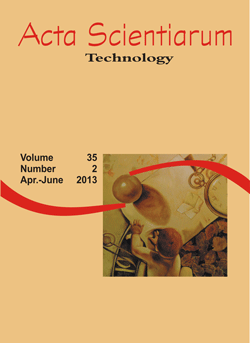<b>Endocrine disruptors in sludge wastewater treatment plants: environmental complications</b> - doi: 10.4025/actascitechnol.v35i2.10619
DOI:
https://doi.org/10.4025/actascitechnol.v35i2.10619Palavras-chave:
ELISA, LC-MS/MS, water ecophysiology, aquatic ecotoxicology, human sewage, water pollution controlResumo
Concern over exposure to endocrine disruptors (EDs) and impacts on wildlife and human has gradually increased in importance in recent years. Wastewater systematically receives most if not all of these chemicals, so a deeper understanding of the fate of EDs in environment is sorely needed. We evaluated EDs concentration in the affluent and effluent from the Sludge Wastewater Treatment Plants (SWTPs) Penha and Ilha do Governador. It was used as evaluation parameter the determination of some target compounds, such as: alkylphenols, 17β-estradiol, bisphenol A; complementing with measures of physical and chemical parameters: temperature, pH, dissolved oxygen, total suspended solids, volatile suspended solids, and total chemical oxygen demand. Samples were collected along the line of treatment of each SWTP, and after laboratory procedures, analyzed by LC-MS/MS and ELISA techniques. In some samples, we verified concentrations of chemical compounds with potential to disrupt the endocrine system of living organisms. Therefore, the release of this effluent, even within the effluent discharge standards (BRASIL, 2005) or in condition to be purified by the water course, may lead to physiological changes in the organisms of the receptor water body.
Â
Downloads
Downloads
Arquivos adicionais
Publicado
Como Citar
Edição
Seção
Licença
DECLARAÇíO DE ORIGINALIDADE E DIREITOS AUTORAIS
Declaro que o presente artigo é original, não tendo sido submetido í publicação em qualquer outro periódico nacional ou internacional, quer seja em parte ou em sua totalidade.
Os direitos autorais pertencem exclusivamente aos autores. Os direitos de licenciamento utilizados pelo periódico é a licença Creative Commons Attribution 4.0 (CC BY 4.0): são permitidos o compartilhamento (cópia e distribuição do material em qualqer meio ou formato) e adaptação (remix, transformação e criação de material a partir do conteúdo assim licenciado para quaisquer fins, inclusive comerciais.
Recomenda-se a leitura desse link para maiores informações sobre o tema: fornecimento de créditos e referências de forma correta, entre outros detalhes cruciais para uso adequado do material licenciado.



















